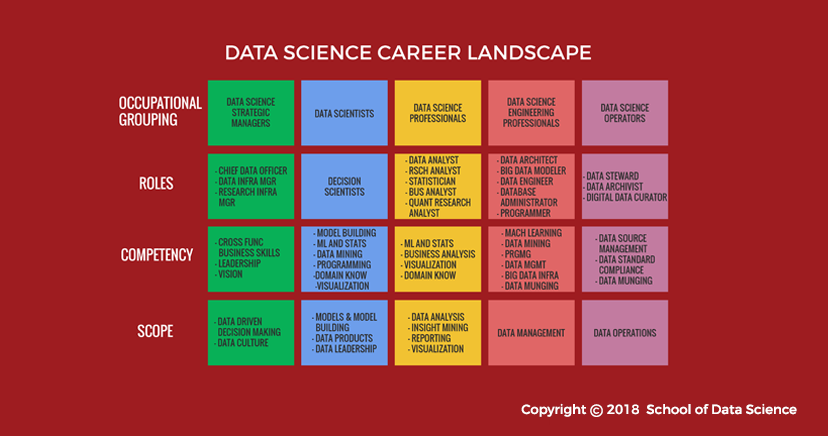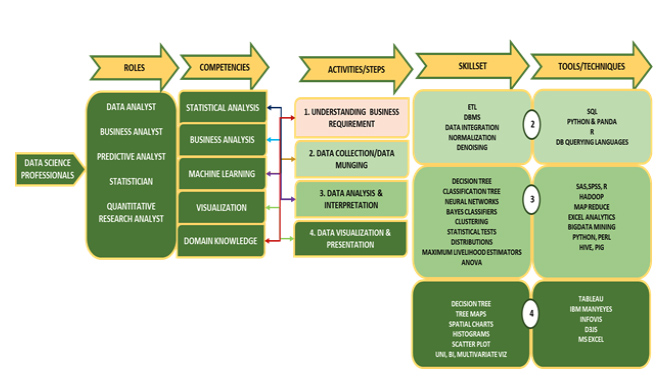Essential Skills of Data Science professionals
If you are new to this post, please read our previous blog here before continuing further.
In the previous blog we saw how Data Science is the century’s hottest career. But how to break in to this intimidating space? Asking questions is easy. But the answers are not always straightforward.
We had a peek into the Data Science career landscape in the previous blog.

Most probably you have heard how difficult it is to become a Data Scientist. This is true! But everybody need not become a Data Scientist. There are plenty of options to aim for, outside the realm of a Data Scientist. The question is how to find the right one for you and how to get a toe in the door.
One such is “Data Science Professionals”. Let’s have a detailed look at this occupation grouping.
The objective is to help you understand the various roles in Data Science, assess the skills you may already have and develop specific skill sets to match the Data Science role that appeals to you.
Understanding The World Of Data Science Professionals

As you can see above, there are many roles open in the space of Data Science Professionals. The competencies and skill sets needed to perform each of these roles efficiently overlaps most often than not. For example, a Statistician and a Business Analyst, both need Statistical analysis skills, business understanding, visualization skills etc.
No matter what the role is named, or which industry you work for, there are a set of steps that any Data Science Professional need to follow. You may skip and jump steps but, pragmatically, any Data Science professional will touch base through all these steps. And each step needs capability to handle specific tools & techniques (as given in the illustration above). This makes understanding of the steps imperative.

The most difficult part in Data Science Profession is not Math. It is Understanding the business requirement. When you have a specific data set with you, you need to know what you’re looking for before starting to work on it. This calls for a deep understanding of the Industry that you work with, domain knowledge, the key performance metrics that need to be looked at, the vision & objective of the task at hand etc. Understanding business requirement is a skill that can only be developed through experience & curiosity to learn.

“Data” is a very ambiguous term. Data does not only come in well structured tables. Most important data are unstructured. They may be collected from random text messages, comments etc. For example, the travel industry looks at quantum of social media comments and posts to understand changes in travel trends, and they use this information to create more customized experiences. Denoising and putting the data together in a structured form takes specific skill sets and understanding of various tools as given above in the illustration. Quality of work at this step will reflect in the quality of visualization & presentation of the results.
Education in Information Technology, knowledge of DBMS, business intelligence systems, ETL tools, data management, data modeling, basic math and statistics etc. are some of the skills that would give you an entry to this space.

Once the data collected is wrangled and put together in the desired form, the dataset is ready to be analyzed. At this stage, the Data Science Professionals use various statistical models and tests to make deductions about the present scenario and extrapolate the future possibilities.
Most analysts will have degrees in fields like math, statistics, computer science, etc. A degree in economics/applied economics/econometrics is well suited for Data Science professional roles. This is because, inference & causal interpretation is part and parcel of economics. Along with this, the skills & tools mentioned in the above given illustration will give you a good break into the Data Science field.

Imagine a situation where you are a chef and you follow a difficult recipe and make the exotic dish that your customer ordered. What would happen if you haphazardly throw it in a plate and serve? The customer would not be able to appreciate the nuances of the dish, nor your efforts that went in to the process. Therefore, it is very important to present your dish in a way that accentuates its effect on the customer.
This holds true for Data Science also. Performing highly technical analysis and finding gems of wisdom about a given problem is not enough. Visualizing and presenting the same in the appropriate way will help decision makers identify patterns and implement changes required.
Along with analytics skills, mastery over various chart types, Excel, and other visualizer tools is important at this step. An analyst should be able to visualize his findings first and create the same using various tools.
Last but not the least, presenting and communicating the findings in the most efficient & appropriate way, so that informed and quick business decisions can be made.
Intellectual curiosity, business acumen & communication skills are the most important non-technical skills required in Data Science.
Given the multitude of opportunities and lightning fast technology, the only way to be on top of your game is to keep upon trends, data environments and new methods through certification, class or conference. The key to long lasting success is to always be hungry for new skills and knowledge.
Watch this space for other Data Science occupations.




